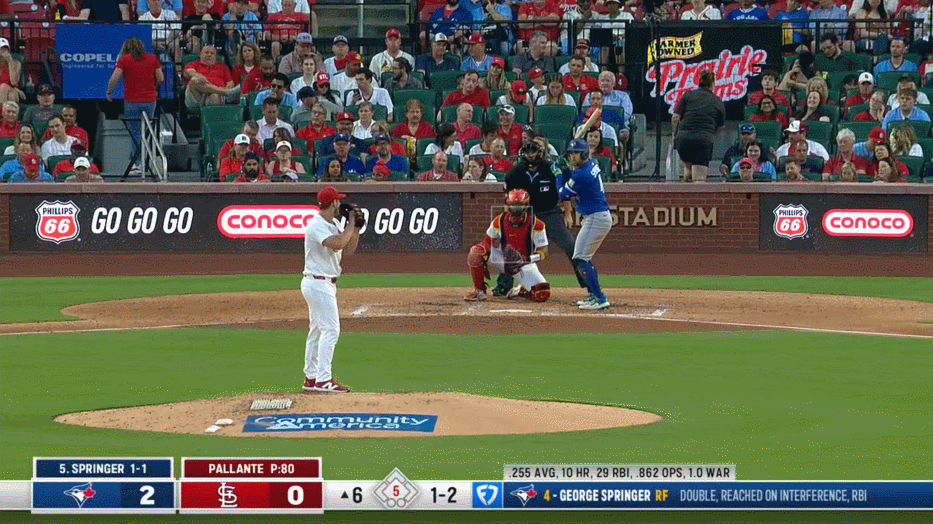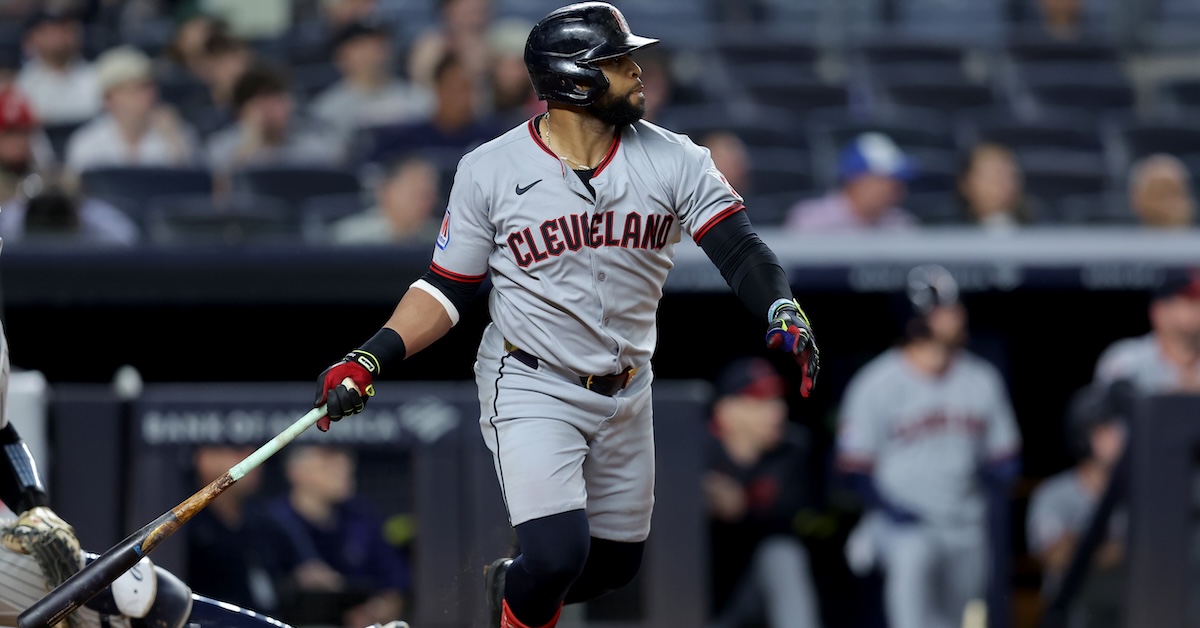Not All Foul Balls Are Created Equal

In the sixth inning of Monday’s game between the Blue Jays and the Cardinals, George Springer got a pitch to hit, a hanging curveball that split the center of the strike zone. He recognized the pitch late and fouled it off:

His post-swing demeanor suggests that he considered it a missed opportunity, and it’s clear to see why. With a pitch like that, he was thinking extra bases; instead, Andre Pallante got a strike for his troubles. Now Springer’s back was against the wall. Pallante came back with a much better pitch on 1-2, but Springer spoiled it:

Unlike the previous miss, this looked like a calculated act to me. Springer was late on the pitch, but it was too close for comfort, so he took a defensive cut, meeting the ball early in his swing and punching it harmlessly away.
Welcome to the confusing world of analyzing foul ball rate. Both of Springer’s swings produced the same result, but the first one was a poor outcome for him and the second a desirable one. You can argue that the second pitch would have been a ball if he hadn’t swung, but he certainly wasn’t sure of that when he committed to swinging; living to fight another day against such a well-located pitch is a good outcome.
You probably wouldn’t be surprised to learn that Luis Arraez, Nick Allen, and Brice Turang are among the leaders in early-count foul ball rate (foul balls per swing). They swing a lot, make a lot of contact, and spray their contact to all fields, including foul territory in every direction. On the other side of the coin, you’ve got sluggers like Bryce Harper, Aaron Judge, Vladimir Guerrero Jr., and yes, Springer. These guys don’t swing as often, which means a few things. First, they swing at better pitches on average, which leads to better contact. Second, they make less contact on average, and less contact means fewer fouls, even for the same rate of fouls-per-contact.
I’d rather be in the second camp than the first there. Early-count foul balls are a waste, literally the same as a swinging strike. They might be worse, even – baserunners can’t steal, catchers can’t block poorly and allow a passed ball. A full 46% of Arraez’s swings – 48% for league leader Wilyer Abreu – end up as foul balls. Sure, contact is great, but when half of it counts as a strike, it’s a lot less enticing.
Things change with two strikes, though. When a foul ball extends the at-bat instead of ending it in a strikeout, it becomes valuable instead of detrimental. Have you ever watched Jake Cronenworth hit? With two strikes, he turns into a lacrosse goalie, trying to redirect everything in the vicinity of the strike zone. He’s not trying to hit a homer unless the pitcher truly grooves him one; he’s specifically looking to avoid a strikeout. Cronenworth sports the highest foul-per-swing rate in baseball with two strikes at 51.2%. It works – he still strikes out a decent amount because of his penchant for running deep counts, but he walks 16% of the time because eventually pitchers miss the zone.
The bottom of the two-strike foul ball rate list, on the other hand, is filled with strikeout-prone types. Javier Báez makes foul contact on just 27% of his two-strike swings. Judge, who still strikes out a ton even as he rewrites the record books, is towards the bottom. So are Jackson Chourio, Shohei Ohtani, Fernando Tatis Jr., Kyle Schwarber, and all nature of excellent sluggers. You can get away with it if you hit like those guys, but Andrew Vaughn, Brenton Doyle, Miguel Andujar, and Michael Toglia are floundering under the weight of their inability to fight pitches off. This isn’t a disqualifying statistic, in other words, but it’s surely a bad thing; it’s directly leading to higher strikeout rates, and unless you have light tower power, many of the pitches you swing at with two strikes aren’t the kind you can hit for extra bases anyway.
I’d posit that high foul ball rates before two strikes are bad, while high foul ball rates with two strikes are good. Early in the count, fouls are a waste, while late in the count, they’re a get out of jail free card. Assuming that these two events are equivalent doesn’t make much sense to me; hitters behave differently, and if we don’t credit them for that different behavior, we’re missing something essential about the act of hitting.
To measure this, I had to put everything on the same scale. I first took every hitter who has swung at 200 or more pitches early in the count, found the average foul ball per swing rate, then normalized each player’s foul ball rate into z-scores. I did the same for every hitter who has swung at 100 or more pitches in two-strike counts. That gave me two scores for every hitter: early-count foul rate and two-strike foul rate. I flipped the sign of the early-count foul rate scores – lower is better – and then summed the two.
This let me separate out the hitters who always have high foul ball rates or always have low foul ball rates – they don’t demonstrate this skill of changing their approach in a measurable way. Arraez, for example, makes foul contact on 46.2% of his early-count swings and 46.3% of his two-strike swings. It’s the same approach, and because the league as a whole cuts down on their swings and makes more foul contact with two strikes, Arraez rates below average in this metric. He’s two standard deviations above average in his early-count foul rate and only 1.6 above average in two-strike foul ball rate, a net of -0.4 for his “foul score.” Allen is even worse – he makes foul contact on 47.1% of early-count swings, but only 39.3% of two-strike swings. When pitchers try to throw the ball past him, they succeed. His foul score is a woeful -2.15.
That’s among the worst marks in the majors, but the actual worst hitter is doing a lot worse than that. That would be Andujar, who is making a ton of foul contact early (44.6%) but almost never when he needs it to stay alive (27.4%). The result is a foul score of -4.2. If you’re wondering why a guy with his skills – solid bat speed, elite contact rate – has never taken off in the majors, it might be related to this. Likewise, if you’re trying to puzzle out what’s ailing Xander Bogaerts this year, it can’t help that he makes foul contact 39% of the time early but only 30% of the time late, for a foul score of -2.2.
Most big leaguers aren’t outliers to this degree. More than 60% of the league has a foul score between -1 and 1, and 93% fall between -2 and 2. The top 10 hitters by this metric have an aggregate wRC+ 20 points higher than the bottom 10, but most players fall into the broad, undifferentiated middle. I’m not saying that this is a skill that everyone in baseball has or should use, but I do think that it’s measuring a real ability.
That brings us back to Springer, a paragon of adaptability. Early in the count, he’s allergic to foul balls, fouling the ball off just 30.6% of the time. Put him in a two-strike count, however, and he goes into protect mode, fouling off the ball with 42% of his hacks. He’s demonstrated some version of this skill throughout his career, in fact. His worst two years for modulating his foul ball rate were 2023 and 2024 – perhaps not coincidentally, those were the two worst offensive years of his career.
Another standout in the field? Springer’s erstwhile teammate, Carlos Correa, who is roughly Springer’s equal in foul score this year and has been even better over the course of his career. Was this part of the Astros’ famed no-strikeouts transformation? I obviously can’t say with any certainty, and they might have been doing a few other things to tilt things in their favor, but a solid approach like this can’t hurt.
It’s not all former Astros. Harper has learned this skill over time. During his Nationals tenure, he didn’t change his approach much at all when reaching two strikes. Since joining the Phillies, however, he’s running one of the largest differences between early-count foul rate and two-strike foul rate in the entire major leagues. And hey, would you look at that, he has a huge foul score this year, too – his 28% early-count foul rate and 37% two-strike foul rate land him fourth in the majors in foul score.
When fans and analysts talk about smart hitters with bat control, I’d argue that they’re implicitly describing this skill. The ability to take different swings depending on the context – prioritizing loud, fair contact early, then choking up and defending late – thrills old-school and new-school fans alike. That ability to adapt is more valuable than always slapping at the ball or always trying to hit it out of the park.
If you’re like me, you have one big question: Is this a sustainable skill, or does it flicker in and out from one year to the next, introducing noise into hitters’ production? The outliers here clearly seem to have an edge – Harper, Springer, and Correa do it consistently. Allen and Andujar have always made more foul contact with two strikes than early in the count; they’ve never possessed this skill. Still, I wanted to check whether it’s a talent (or hinderance) held by only a few.
To do so, I took data from 2023 and 2024. I identified the top 10% and bottom 10% of hitters in 2023, then compared their performance to 2024. The top 10% of hitters averaged a score of 1.7 in 2023 and 0.6 in 2024. The bottom 10% of hitters averaged -2 in 2023 and -0.4 in 2024. Expand it to the top 25%, and you get a similar result: 1.2 in 2023 and 0.3 in 2024 for the top 25%, -1.6 in 2023 and -0.4 in 2024 for the bottom 25%. There was a 0.3 correlation between year-one foul score and year-two foul score. It’s a real skill – not as strong as, say, home run rate or swinging strike rate, but nevertheless something where hitters who are good at it in one year tend to be good at it in the next.
So the next time you see George Springer foul off an early hanging breaking ball, you’ll know: That’s a rare event. And next time you see Bryce Harper turn an 0-2 count into an all-out foul ball battle, yep, that’s years of training showing through. These guys are good at what they do, and it’s a thing that you, the fan, implicitly know is a good thing. Isn’t baseball cool?








